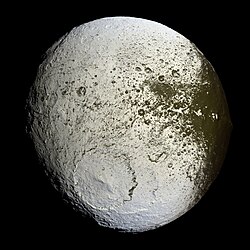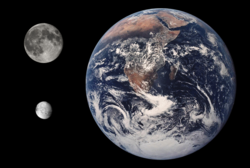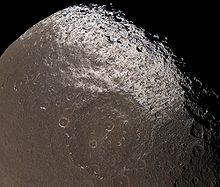Iapetus (moon)
| Iapetus | |
|---|---|

|
|
| Iapetus, taken by Cassini on September 8, 2007 from a distance of 75,000 km | |
| Central body | Saturn |
| Properties of the orbit | |
| Major semi-axis | 3,561,300 km |
| Periapsis | 3,460,600 km |
| Apoapsis | 3,662,000 km |
| eccentricity | 0.02828 |
| Orbit inclination | 7.52 ° |
| Orbital time | 79.33 d |
| Mean orbital velocity | 3.26 km / s |
| Physical Properties | |
| Albedo | 0.05 to 0.5 (visually geometric) |
| Apparent brightness | Average value: 10.0 mag |
| Medium diameter | 1436 km |
| Dimensions | 1.6 x 10 21 kg |
| surface | 6,700,000 km 2 |
| Medium density | 1.27 g / cm 3 |
| Sidereal rotation | 79.33 days |
| Axis inclination | 0 ° |
| Acceleration of gravity on the surface | 0.2553 m / s 2 |
| Escape speed | 606 m / s |
| discovery | |
| Explorer | |
| Date of discovery | October 25, 1671 |
| Remarks | Simply bound rotation. The inclination of the orbit relates to the Laplace plain. |

|
|
| Size comparison between Iapetus (bottom left), Earth's moon (top left) and Earth (true to scale photo montage) | |
Iapetus or Japetus (also Saturn VIII ) is the third largest moon on the planet Saturn . It was discovered in 1671, orbits relatively far out and has two different hemispheres with a brightness ratio of 1:12.
properties
Orbit and rotation
train
Iapetus orbits Saturn at a mean distance of 3,561,300 km in 79 days, 7 hours and 55 minutes. The orbit has an eccentricity of 0.0283 and is 7.52 ° inclined to the Laplace plane, which at this distance from Saturn is inclined about 14.8 ° to the equatorial plane . Besides the moon Phoebe, Iapetus is the only large Saturn moon whose orbit shows a significant inclination. Of all the large moons over 500 km in diameter in the solar system , it is the one with the greatest inclination (with the exception of the irregular Neptune moon Triton , which orbits the planet in retrograde), the largest semi-axis and the longest orbital period.
rotation
Iapetus has a rotation of 79 days, 7 hours and 55 minutes that is linked to its orbital period . Its axis of rotation is exactly perpendicular to its plane.
construction
Physical and chemical structure
Iapetus has a mean diameter of 1,436 km. Its low density of 1.27 g / cm 3 indicates that it is composed almost entirely of water ice with a small amount of silicate rock.
surface
Iapetus' surface has two distinctly different regions. The front hemisphere in the direction of movement is as dark as coal, with an albedo of 0.03 to 0.05, with a slightly reddish tint, while the following hemisphere has an albedo of 0.5 to 0.6, the trailing hemisphere is almost as bright as Jupiter's moon Europa ; its northern part was christened Roncevaux Terra and its southern part Saragossa Terra. The dark region was named Cassini Regio after Iapetus' discoverer, Giovanni Domenico Cassini . The difference in brightness is so great that Cassini reported that he could only observe the moon with his telescope on one side of Saturn. If the moon turned the dark region towards the earth, it remained invisible to the observer at the time. Iapetus has the greatest contrast in brightness of all known bodies in the solar system.
The bright side is icy and heavily cratered . The polar regions are also free of dark materials.
The dark materials could be deposits of organic compounds , such as those found in primitive meteorites ( e.g. carbonaceous chondrites ) or on the surface of comets . In addition, they could contain cyanides such as frozen hydrogen cyanide polymers . This is indicated by earth-based observations. The origin of the dark material is not clear, so far several theories are available. The layer thickness of the material is also unclear. If the dark layer is thin, it would have to be constantly renewed, as lighter material would be ejected from the subsurface in the event of an impact .
The dark material could have come from inside the moon and came to the surface through a combination of impact events and volcanism . This theory is supported by the concentrated occurrence of craters at the bottom. Iapetus formed at a large distance from Saturn and was exposed to less high temperatures when the solar system was formed, so that it was able to bind volatile components such as methane or ammonia inside . These could later have reached the surface through geological processes such as cryovolcanism (cold volcanism) and converted into dark compounds by UV radiation from the sun , ionized particles or cosmic radiation . At the border between the light and the dark hemisphere, a dark ring with a diameter of 100 km can be seen, which is reminiscent of structures on the Earth's moon or Mars , where volcanic lava flowed into impact craters with a central mountain.
One theory (based on the Cassini flyby on September 10, 2007) states that a very thin layer from the outside could have reached the actually white surface of Iapetus and that a melting or sublimation effect could have occurred due to the higher energy absorption of the dark material that brought out darker rock masses. In addition, smaller (30–60 m diameter) bright impact craters were observed, which provide clear indications of the layer thickness and origin of the dark material. Since the depth of a crater with a diameter of 60 m is approx. 10 m, it is clear that the dark material must be thinner.
According to another theory, the dark material comes from the moon Phoebe . It could have been released by the impact of micrometeorites and collected on Iapetus' leading hemisphere. This theory is strengthened by the discovery of another, very extensive ring of Saturn, the Phoebe ring , by the Spitzer Space Telescope on October 6, 2009. It is assumed that the material of this ring comes from Phoebe, since its orbit is pretty much within the Runs around. This retrograde ring begins at a distance of about 6 million kilometers from Saturn. The right-handed Iapetus thus moves in the opposite direction through the edge areas of the ring, which would plausibly explain the material transfer.
However, Phoebe's coloration differs somewhat from the coloration of the deposits on Iapetus. The theory that the deposits originate from Phoebe is rejected by some researchers ( T. Owen et al. ). Based on spectroscopic measurements, they favor the origin of the dark material from Saturn's moon Titan .
Another great mystery is a train of mountain ridges discovered in the Cassini pictures, which extends along the geographical equator through Cassini Regio to within a few degrees of latitude . In the photos, the phenomenon can be clearly seen as a broad band, through which the moon appears almost as if composed of two parts on its dark-colored side (" walnut shape" of the Iapetus). The mountain range has so far been observed over a length of 1300 kilometers. It reaches a width of up to 20 kilometers and a maximum height of 13 kilometers.
How the mountain range came into being is still in the dark. Scientists consider two theories to be possible: On the one hand, the elevation could have been formed by tectonic processes, i.e. by folding similar to the European Alps on Earth. On the other hand, liquid material from the subsurface could have emerged through a crack in the moon's crust and accumulated until it appears today. According to a completely different hypothesis ( Wing-Huen Ip ), it concerns the debris of a fallen ring , which was either a remnant of the gas and dust disk from which Iapetus formed, or the result of the impact of a large asteroid and the material thrown out as a result.
According to more recent research, the mountain range is said to have originated from the fact that Iapetus rotated quickly in his youth and was not yet frozen because he was heated by radioactive substances ( 26 aluminum and 60 iron ) with a relatively short half-life. The rapid rotation gave it a bulging shape. The activity of the isotopes decreased and Iapetus froze before the rotation duration increased to its present value. The bulging shape actually had to go back. But that was no longer possible due to the freezing. The material therefore accumulated at the formerly highest point, the equator.
Of the 58 named craters of the Iapetus, 20 have a diameter of at least 100 km. By far the largest crater, called Abisme, measures 767.74 km - more than half the diameter of Iapetus. He is in the middle of the northern half of the leading hemisphere in the dark terrain. Inside the large, but visually hardly noticeable depression, Iapetus' fifth largest crater, Falsaron, stands out more clearly with a diameter of 424 km.
exploration
discovery
Iapetus was discovered by Giovanni Domenico Cassini on October 25, 1671 .
The moon was named after the titan Iapetos from Greek mythology . The name "Iapetus" and the names of seven other Saturn moons were proposed by Wilhelm Herschel's son, the astronomer John Herschel , in an 1847 publication "Results of Astronomical Observations made at the Cape of Good Hope " .
Exploration by spacecraft
As the first space probe , Pioneer 11 came relatively close to it on August 29, 1979 with a smallest distance of 1033 mm. The mass could be roughly estimated from the deflection of the probe by the moon's gravitational field.
After Voyager 1 in November 1980, Voyager 2 passed the Saturn system in August 1981. This took the first detailed recordings of Iapetus on August 22, 1981, the closest distance between Iapetus and the space probe was 909,000 km. During their one-time flyby, it was possible to record individual structures and then map the Trabant with low resolution.
On January 1, 2005, the Cassini Iapetus space probe passed for the first time at a distance of 123,000 km and delivered the first high-resolution images of the moon. Another targeted flyby took place on September 10, 2007. The probe flew past the moon at a distance of just 1,640 kilometers, making even more detailed images.
reception
In Arthur C. Clarke's novel 2001: A Space Odyssey , Iapetus is an extraterrestrial constructed star gate or wormhole , chosen because of the unusual and unexplained properties of the moon.
In Jack McDevitt's novel God's Machines , an ice statue of extraterrestrial origin found on Iapetus plays a role.
Kim Stanley Robinson describes in the novel 2312 a (human) city that stretches along a road on the ridge of Iapetus around the whole moon.
Web links
- Iapetus in the Gazetteer of Planetary Nomenclature of the IAU (WGPSN) / USGS
- Current Cassini images from Iapetus a picture gallery of the field of planetology and remote sensing at the Free University of Berlin under the direction of Cassini team member Gerhard Neukum
- NASA: Cassini Exposes Saturn's Two-Face Moon (English)
- NASA: Encountering Iapetus (English)
- Voyager 1 and 2 - Atlas of Six Saturnian Satellites NASA maps of six Saturn moons based on images from the Voyager probes
- Abstract of the work by T. Owen et al. on the origin of the dark material on Iapetus
Individual evidence
- ^ NASA: Saturnian Satellite Fact Sheet. October 13, 2015, accessed July 16, 2015
- ↑ DLR Institute for Planetary Research: Cassini-Huygens ( Memento of the original from May 2, 2007 in the Internet Archive ) Info: The archive link was inserted automatically and has not yet been checked. Please check the original and archive link according to the instructions and then remove this notice. Datasheet of Saturn's moons
- ↑ NASA Jet Propulsion Laboratory, Cassini Solstice Mission: - ( Memento of the original from March 26, 2015 in the Internet Archive ) Info: The archive link was automatically inserted and not yet checked. Please check the original and archive link according to the instructions and then remove this notice.
- ↑ Raumfahrer.net: Iapetus' yin-yang puzzle is solved , accessed on January 5, 2010
- ↑ The King of Rings. NASA, October 7, 2009, accessed October 8, 2009 .
- ↑ http://www.astronews.com/news/artikel/2007/07/0707-025.shtml
- ↑ http://www.jpl.nasa.gov/news/news.cfm?release=2007-079
- ^ Iapetus in the Gazetteer of Planetary Nomenclature of the IAU (WGPSN) / USGS ; last accessed on September 28, 2016.
- ^ Cassini: A Discovery of Two New Planets about Saturn, Made in the Royal Parisian Observatory by Signor Cassini, Fellow of Both the Royal Societys, of England and France; English isn't out of French. Phil. Trans. January 1, 1673 8: 5178-5185; doi: 10.1098 / rstl.1673.0003 ( full text )
- ↑ Campbell, JK & Anderson, JD (1989) Gravity field of the Saturnian system from Pioneer and Voyager tracking data . Astronomical Journal (ISSN 0004-6256), vol. 97, May 1989, p. 1485-1495.
- ↑ http://www.astronews.com/news/artikel/2007/09/0709-007.shtml
- ↑ http://www.spaceflightnow.com/news/n0709/12iapetus/
| further inside | Saturn moons | further outside |
| Hyperion |
Semi- major axis (km) Iapetus 3,560,800 |
Kiviuq |



